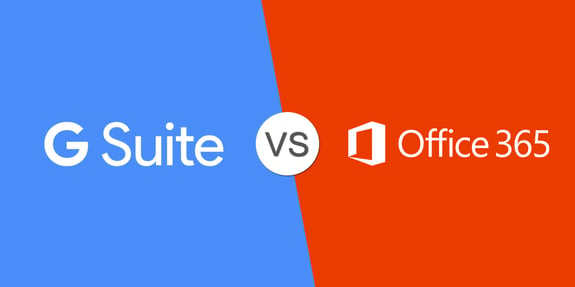Brand loyalty plays a huge part in how we spend our money. And while there are a lot of top software brands, Microsoft and Google tend to be top of mind. This is expressly accurate when considering business email options.
But how do you pick one when they both offer such similar functionality? Especially now that they both have such strong Cloud presence.
Email support is a huge part of what we do at VC3, Inc. A common question we get is: Which is better for email – Office 365 or G Suite? The truth is, understanding the difference between the options will guide your company to the right one.
Office 365 and G Suite both offer reliable email options. Here’s a quick rundown to help you figure out which is best for your business.
Microsoft’s Office 365 vs Google’s G Suite
Our goal is to assist you in comparing price, email storage size, file storage space, and of course, ease of use. Also, which is more user-friendly and which is more intuitive?
Pricing Structure, Mailbox Storage, and File Storage
Google offers two simple standard paid plans. While Microsoft offers many options and pricing plans, to accommodate your business needs.
In the interest of fairness, we’ve compared Microsoft’s best match to Google’s standard options. This way you’re seeing apples-to-apples.
Office 365 Business Essential vs G Suite Basic
|
|
Microsoft Office 365 Business Essential |
G Suite Basic |
|---|---|---|
|
Pricing Structure |
$5 or $6 /month |
$5 /month |
|
Mailbox Storage |
50 GB |
30 GB total for both mailbox and file storage |
|
File Storage |
1 TB |
Office 365 Enterprise vs G Suite Business
|
|
Microsoft Office 365 Enterprise E3 |
G Suite Business |
|---|---|---|
|
Pricing Structure |
$20/month |
$10 /month |
|
Mailbox Storage |
Unlimited for both with yearly commitment |
Unlimited for both mailbox and file storage ** |
|
File Storage |
** G Suite Business unlimited is based on having five or more accounts. The program is restricted to 1TB per user when there are less than five users.**
Email Aesthetics, Features, and Integrations
Aesthetics
At first glance, you’ll notice that they look completely different. G Suite looks more straightforward, while Office 365 offers many more options. Both platforms offer some interface customization, such as changing color schemes. Even so G Suite remains the more “industrial” looking option. While Office 365 appears to have put more thought into beautifying their product. Both are user-friendly once you get used to the different interfaces.
Features
Office 365’s Outlook wins on features, hands down.
G Suite’s Gmail offers basic functionality, but really falls flat beyond that. Most notable missing features:
- Integrated photo viewer
- Instant actions (the ability to delete or flag an email quickly)
- Social media integration
Not to mention my favorite email feature: Rules. You can tailor your email, both incoming and outgoing mail into as many folder/categories as you can think up. Gmail’s “filtering” settings don’t give as many options or the ability to group sent mail. Outlook soars when it comes to sort and grouping features.
What they have in common is their calendar. Both have the option of linking to their account and others in the workplace. Both make and track meetings with scheduled meeting assistance. This feature includes things like booking meeting rooms, or meeting alters times.
So, yes, Gmail missed the boat on features, but they do offer a better search functionality and more speed. Plus Gmail offers more third-party apps which could make for the lack of features.
Integrations
Speaking of third-party apps, this is where G Suite edges out Office 365. G Suite’s “integration-friendly” platform gives way to so many more apps, when compared to Office 365.
As an Office 365 user myself, I can’t tell you how many times I’ve been disappointed in this area. I’ll hear about an awesome app with incredible business features, only to find out it’s not Office 365 supported.
Installed vs Online Word Processor, Spreadsheet, and Presentation Components
No matter which platform you pick, they both come with a word processor, spreadsheet, and presentation components. Microsoft has the most well known/used versions of these with Word, Excel, and PowerPoint. With the added bonus that Outlook is also available as a desktop app.
The biggest difference outside of familiarity is installed vs online platforms. With Microsoft, you have access to their suite online, and as well as the option to download and install the program on your device(s). Whereas with Google’s G Suite, Gmail, Docs, Sheets and Slides – online is all you get.
You can work with G Suite offline, but the configuration is rough. And most people don’t enjoy the process of then syncing your offline to online once you have Internet again.
To sum it up, when picking an email provider, ask yourself these questions:
- What kind of interface do I want?
- Do I want the option to install on my devices?
- Do I plan on buying an annual or monthly plan?
- How many email accounts do I need?
- How much storage do I need?
- How important are features and which ones do I need?
Your comfort and budget will most likely be the deciding factor between choosing between Google’s G Suite and Microsoft’s Office 365. They both have various price points and options to keep any business running smoothly. If you still don’t know which is best for you, that’s okay – talk with your IT provider. Together, map the future of your company’s email experience.
Related: IT Untangled: Best Options for Small Business Email Service


